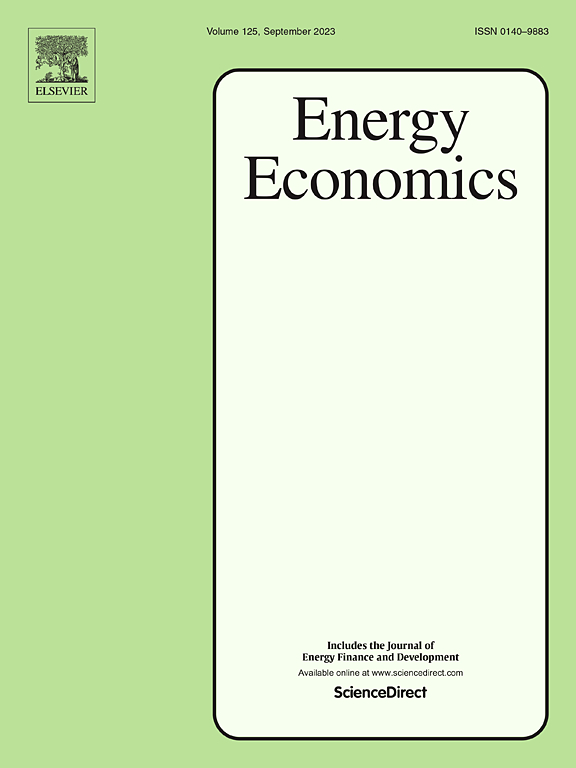应对极端风险溢出效应:在中国建立稀土、绿色债券和清洁能源市场的协同网络
IF 14.2
2区 经济学
Q1 ECONOMICS
引用次数: 0
摘要
稀土作为推进绿色低碳经济转型的重要资源,在塑造与绿色金融资产的动态关系方面发挥着关键作用。利用2012年10月9日至2023年9月28日的数据,采用分位数向量自回归(QVAR)模型,考察了不同分位数制度下中国稀土元素、绿色债券和清洁能源股票的时变关联关系,并进一步探讨其驱动因素。研究结果揭示了几个关键的见解。首先,稀土市场、绿色债券市场和清洁能源股票市场之间存在显著的风险传染效应,这种效应在极端市场条件下更为明显。其次,在正常市场条件下,稀土和绿色债券市场主要充当净风险接受者,而大多数清洁能源股票指数充当净风险发射器。然而,在极端的市场条件下,这些金融资产的角色发生了显著的变化。第三,重大事件加剧了稀土、绿色债券和清洁能源股票市场之间的风险传导,改变了它们在溢出网络中的角色。最后,在极低分位数、中分位数和极高分位数的溢出效应的主要驱动因素分别是GPR、投资者情绪和CPU。这些结果为了解绿色金融市场的动态提供了新的见解,为清洁能源领域的投资者和政策制定者提供了有价值的启示。本文章由计算机程序翻译,如有差异,请以英文原文为准。
Navigating extreme risk spillovers: Building a synergistic network of rare earths, green bonds, and clean energy markets in China
Rare earths, as a vital resource for advancing the transition to a green and low-carbon economy, play a critical role in shaping the dynamic relationship with green financial assets. Using data from October 9, 2012 to September 28, 2023, this study employs a Quantile Vector Autoregression (QVAR) model to examine the time-varying associations among Chinese rare earth elements, green bonds, and clean energy stocks under different quantile regimes and further explores their driving factors. The findings reveal several key insights. First, there is a significant risk contagion effect among the rare earth, green bond, and clean energy stock markets, which is more pronounced under extreme market conditions. Second, during normal market conditions, the rare earth and green bond markets primarily function as net risk receivers, whereas most clean energy stock indexes act as net risk transmitters. However, under extreme market conditions, the roles of these financial assets shift notably. Third, major events intensify risk transmission among the rare earth, green bond, and clean energy stock markets while altering their roles within the spillover network. Finally, the main drivers of the spillover effect at extremely low, medium and extremely high quantiles are GPR, investor sentiment and CPU, respectively. These results offer new insights into the dynamics of the green financial market, providing valuable implications for investors and policymakers in the clean energy sector.
求助全文
通过发布文献求助,成功后即可免费获取论文全文。
去求助
来源期刊

Energy Economics
ECONOMICS-
CiteScore
18.60
自引率
12.50%
发文量
524
期刊介绍:
Energy Economics is a field journal that focuses on energy economics and energy finance. It covers various themes including the exploitation, conversion, and use of energy, markets for energy commodities and derivatives, regulation and taxation, forecasting, environment and climate, international trade, development, and monetary policy. The journal welcomes contributions that utilize diverse methods such as experiments, surveys, econometrics, decomposition, simulation models, equilibrium models, optimization models, and analytical models. It publishes a combination of papers employing different methods to explore a wide range of topics. The journal's replication policy encourages the submission of replication studies, wherein researchers reproduce and extend the key results of original studies while explaining any differences. Energy Economics is indexed and abstracted in several databases including Environmental Abstracts, Fuel and Energy Abstracts, Social Sciences Citation Index, GEOBASE, Social & Behavioral Sciences, Journal of Economic Literature, INSPEC, and more.
 求助内容:
求助内容: 应助结果提醒方式:
应助结果提醒方式:


